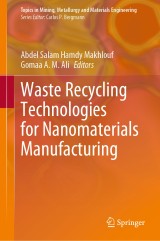Details

Waste Recycling Technologies for Nanomaterials Manufacturing
Topics in Mining, Metallurgy and Materials Engineering
|
160,49 € |
|
| Verlag: | Springer |
| Format: | |
| Veröffentl.: | 09.05.2021 |
| ISBN/EAN: | 9783030680312 |
| Sprache: | englisch |
Dieses eBook enthält ein Wasserzeichen.
Beschreibungen
<div>This book discusses the recent advances in the wastes recycling technologies to provide low-cost and alternative ways for nanomaterials production. It shows how carbon nanomaterials can be synthesized from different waste sources such as banana fibers, argan (Argania spinosa) seed shells, corn grains, camellia oleifera shell, sugar cane bagasse, oil palm (empty fruit bunches and leaves) and palm kernel shells. Several nanostructured metal oxides (MnO2, Co3O4,….) can be synthesized via recycling of spent batteries. The recovered nanomaterials can be applied in many applications including: Energy (supercapacitors, solar cells, etc.) water treatments (heavy metal ions and dyes removal) and other applications. Spent battery and agriculture waste are rich precursors for metals and carbon, respectively. The book also explores the various recycling techniques, agriculture waste recycling, batteries recycling, and different applications of the recycled materials. </div>
Waste Recycling Technologies for Nanomaterials Manufacturing: Fundamental, Current Prospects, and Future Trends.- Recycling, Management, Valorization of Industrial Solid Wastes.- Introduction: Environmental, Suceptbility and Nano-waste.- : Recycling of Cobalt Oxides Electrodes from Spent Lithium-Ion Batteries by Electrochemical Method.- Recovery of Nanomaterials for Battery Application.- Cost-Effective Nanomaterials Fabricated Recycling Spent Batteries.- Recycled Nanomaterials for Energy Storage (Supercapacitor) Applications.- Recovery of Metal Oxide Nanomaterials from Electronic Waste Materials.- Nanosensors and Nanobiosensors for Monitoring the Environmental Pollutants.- Waste Recovered Nanomaterials for Emerging Electrocatalytic Applications.- Recycling of Nanosilica Powder from Bamboo Leaves and Rice Husks for Forensic Applications.- Recycling of nano-silica from agricultural, electronic, and industrial waste for wastewater treatment.- Extraction of Silica and Lignin-Based Nanocomposite Materials from Agricultural Waste for Wastewater Treatment Using Photocatalysis Technique.- Waste Recycling Technologies for Nanomaterials Manufacturing.- Recent trends of recycled nanomaterials and their outstanding applications: carbon-based nanomaterials as examples.- Hetero-Atoms Doped Porous Carbon Nanostructures Recovered from Agriculture Waste for Energy Conversion and Storage.- Activated Carbon-based Materials in removal of organic pollutant from Wastewater.- Rice Husk Derived Nanomaterials for Potential Applications.- Recycle Strategies to Deal with Metal Nanomaterials by Using Aquatic Plants Through Phytoremediation Technique.- Advanced Waste Recycling Technologies to Manufacturing Nanomaterials for Green Energy: Current Status and Future Perspectives.- Nanoformulated materials from citrus wastes.- Bottom-Up Approach through Microbial Green Biosynthesis of Nanoparticles from Waste.- : Conversion of Waste Cheap Petroleum Paraffinic Wax By-Products to Expensive Valuable Multiple Carbon Nanomaterials.- Recycling Polyethylene tirephthalate (PET) Waste to Magnetic Carbon/Iron.- Recycling of Waste Plastic-Based Nanomaterials and their Applications.- Recycling Nanofibers from Polyethylene Terephthalate Waste using Electrospinning Technique.- Reinforcement of Petroleum Wax By-Product Paraffins as Phase Change Materials for Thermal Energy Storage by Recycled Nanomaterials.- Manufacturing of Nano-Alumina By Recycling Cans Waste
This book discusses the recent advances in the wastes recycling technologies to provide low-cost and alternative ways for nanomaterials production. It shows how carbon nanomaterials can be synthesized from different waste sources such as banana fibers, argan (Argania spinosa) seed shells, corn grains, camellia oleifera shell, sugar cane bagasse, oil palm (empty fruit bunches and leaves) and palm kernel shells. Several nanostructured metal oxides (MnO2, Co3O4,….) can be synthesized via recycling of spent batteries. The recovered nanomaterials can be applied in many applications including: Energy (supercapacitors, solar cells, etc.) water treatments (heavy metal ions and dyes removal) and other applications. Spent battery and agriculture waste are rich precursors for metals and carbon, respectively. The book also explores the various recycling techniques, agriculture waste recycling, batteries recycling, and different applications of the recycled materials.
Shows waste recycling technologies to produce nanomaterials Presents economic aspects and statistics Provides methods for waste recycle
Diese Produkte könnten Sie auch interessieren:

Neutron Applications in Earth, Energy and Environmental Sciences

von: Liyuan Liang, Romano Rinaldi, Helmut Schober

149,79 €

Nanobioelectronics - for Electronics, Biology, and Medicine

von: Andreas Offenhäusser, Ross Rinaldi

96,29 €














